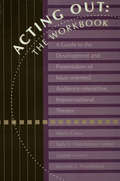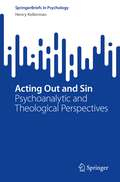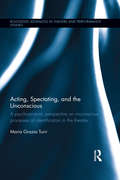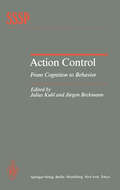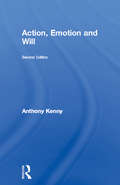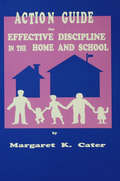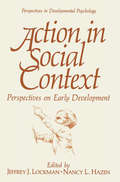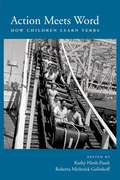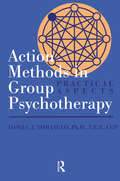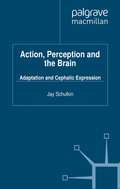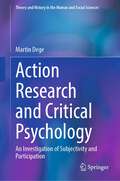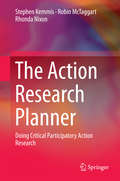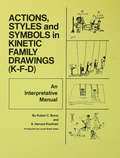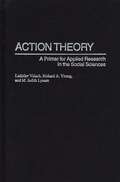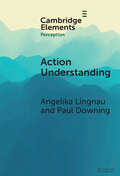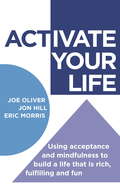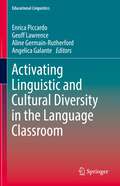- Table View
- List View
Acting Out: A Guide To The Development And Presentation Of Issue-Oriented, Audience- interactive, improvisational theatre
by Mario Cossa Sally Ember Lauren Glass Jennifer RussellFirst published in 1996. Routledge is an imprint of Taylor & Francis, an informa company.
Acting Out: A Guide To The Development And Presentation Of Issue-Oriented, Audience- interactive, improvisational theatre
by Mario Cossa Sally Ember Lauren Glass Jennifer RussellFirst published in 1996. Routledge is an imprint of Taylor & Francis, an informa company.
Acting Out and Sin: Psychoanalytic and Theological Perspectives (SpringerBriefs in Psychology)
by Henry KellermanThis brief treatise explores the common threads to psychoanalytic thought and theological theory. It uses a psychoanalytic lens to examine Judeo/Christian concepts of individual will, consciousness and the unconscious, and the apparent confounding idea of sin. What is new is that the definition of sin is revealed as a psychoanalytic translation of acting-out. Focusing on the behavior of acting-out it illuminates ideas that are part of Western cultural tradition providing insights to those interested in the psychology, and its history and philosophy. As such, it is a highly relevant work for psychologists, psychiatrists, and psychoanalysts, as well as for a comparative study of psychoanalytic and theological intersecting structures.
Acting, Spectating and the Unconscious: A psychoanalytic perspective on unconscious mechanisms of identification in spectating and acting in the theatre. (Routledge Advances in Theatre & Performance Studies)
by Maria Grazia TurriFrom Aristotle’s theory of tragic katharsis onwards, theorists of the theatre have long engaged with the question of what spectatorship entails. This question has, directly or indirectly, often been extended to the investigation of acting. Acting, Spectating, and the Unconscious approaches the unconscious aspects of spectatorship and acting afresh. Interweaving psychoanalytic descriptions of processes such as transference, unconscious phantasy, and alpha-function with an in-depth survey of theories of spectating and acting from thinkers such as Brecht, Diderot, Rousseau and Plato, Maria Grazia Turri offers a significant insight into the emotions inherent in both the art of the actor, and the spectator’s experience. A compelling investigation of the unconscious communication between spectators and actors, this volume is a must-read for students and scholars fascinated by theatre spectatorship.
Acting, Spectating and the Unconscious: A psychoanalytic perspective on unconscious mechanisms of identification in spectating and acting in the theatre. (Routledge Advances in Theatre & Performance Studies)
by Maria Grazia TurriFrom Aristotle’s theory of tragic katharsis onwards, theorists of the theatre have long engaged with the question of what spectatorship entails. This question has, directly or indirectly, often been extended to the investigation of acting. Acting, Spectating, and the Unconscious approaches the unconscious aspects of spectatorship and acting afresh. Interweaving psychoanalytic descriptions of processes such as transference, unconscious phantasy, and alpha-function with an in-depth survey of theories of spectating and acting from thinkers such as Brecht, Diderot, Rousseau and Plato, Maria Grazia Turri offers a significant insight into the emotions inherent in both the art of the actor, and the spectator’s experience. A compelling investigation of the unconscious communication between spectators and actors, this volume is a must-read for students and scholars fascinated by theatre spectatorship.
Action Control: From Cognition to Behavior (Springer Series in Social Psychology)
by JürgenBeckmann JuliusKuhl"It is not thought as such that can move anything, but thought which is for the sake of something and is practical." This discerning insight, which dates back more than 2000years to Aristotle, seems to have been ignored by most psycholo gists. For more than 40years theories of human action have assumed that cogni tion and action are merely two sides of the same coin. Approaches as different as S-O-R behaviorism,social learning theory, consistency theories,and expectancy value theories of motivation and decision making have one thing in common: they all assume that "thought (or any other type of cognition) can move any thing," that there is a direct path from cognition to behavior. In recent years, we have become more and more aware of the complexities in volved in the relationship between cognition and behavior. People do not always do what they intend to do. Aside from several nonpsychological factors capable of reducing cognition-behavior consistency, there seems to be a set of complex psychological mechanisms which intervene between action-related cognitions, such as beliefs, expectancies, values, and intentions,and the enactment of the be havior suggested by those cognitions. In our recent research we have focused on volitional mechanismus which presumably enhance cognition-behavior consistency by supporting the main tenance of activated intentions and prevent them from being pushed aside by competing action tendencies.
Action, Emotion and Will: 1963 Edition
by Dr Anthony Kenny Anthony KennyAction, Emotion and Will was first published in 1963, when it was one of the first books to provoke serious interest in the emotions and philosophy of human action. Almost forty years on, Anthony Kenny's account of action and emotion is still essential reading for anyone interested in these topics.The first part of the book takes an historical look at the emotions in the work of Descartes, Locke and particularly Hume. In the second part, Kenny moves on to discuss some of the experimental work on the emotions by 20th Century psychologists like William James. Separate chapters cover feelings, motives, desire and pleasure. This edition features a brand new preface by the author.
Action, Emotion and Will
by Dr Anthony Kenny Anthony KennyAction, Emotion and Will was first published in 1963, when it was one of the first books to provoke serious interest in the emotions and philosophy of human action. Almost forty years on, Anthony Kenny's account of action and emotion is still essential reading for anyone interested in these topics.The first part of the book takes an historical look at the emotions in the work of Descartes, Locke and particularly Hume. In the second part, Kenny moves on to discuss some of the experimental work on the emotions by 20th Century psychologists like William James. Separate chapters cover feelings, motives, desire and pleasure. This edition features a brand new preface by the author.
Action Guide For Effective Discipline In The Home And School
by Margaret K. CaterFirst published in 1992. Routledge is an imprint of Taylor & Francis, an informa company.
Action Guide For Effective Discipline In The Home And School
by Margaret K. CaterFirst published in 1992. Routledge is an imprint of Taylor & Francis, an informa company.
Action in Social Context: Perspectives on Early Development (Perspectives in Developmental Psychology)
by Jeffrey J. Lockman and Nancy L. HazenThis is a book about the development of action and skill in the first years of life. But it differs in an important way from most past treatments of the subject. The present volume explores how the development of ac tion is related to the contexts, especially the social ones, in which actions function. In past work, little attention has focused on this relationship. The prevailing view has been that infants develop skills on their own, independent of contributions from other individuals or the surrounding culture. The present volume is a challenge to that view. It is based on the premise that many early skills are embedded in interpersonal activities or are influenced by the activities of other individuals. It assumes further that by examining how skills function in interpersonal contexts, insights will be gained into their acquisition and structuring. In effect, this vol ume suggests that the development of cognitive, perceptual, and motor skills needs to be reexamined in relation to the goals and contexts that are inherently associated with these skills. The contributors to the vol ume have all adopted this general perspective. They seek to understand the development of early action by considering the functioning of action in context. Our motivation for addressing these issues stemmed in part from a growing sense of dissatisfaction as we surveyed the literature on skill development in early childhood.
Action Meets Word: How Children Learn Verbs
by Kathy Hirsh-Pasek Roberta Michnick GolinkoffAlthough there has been a surge in our understanding of children's vocabulary growth, theories of word learning lack a primary focus on verbs and adjectives. Researchers throughout the world recognize how our understanding of language acquisition can be at best partial if we cannot comprehend how verbs are learned. This volume represents a proliferation of research on the frontier of early verb learning, enhancing our understanding of the building blocks of language and considering new ways to assess key aspects of language growth.
Action Meets Word: How Children Learn Verbs
by Kathy Hirsh-Pasek Roberta Michnick GolinkoffAlthough there has been a surge in our understanding of children's vocabulary growth, theories of word learning lack a primary focus on verbs and adjectives. Researchers throughout the world recognize how our understanding of language acquisition can be at best partial if we cannot comprehend how verbs are learned. This volume represents a proliferation of research on the frontier of early verb learning, enhancing our understanding of the building blocks of language and considering new ways to assess key aspects of language growth.
Action Methods In Group Psychotherapy: Practical Aspects
by Daniel J. TomasuloFirst published in 1999. Routledge is an imprint of Taylor & Francis, an informa company.
Action Methods In Group Psychotherapy: Practical Aspects
by Daniel J. TomasuloFirst published in 1999. Routledge is an imprint of Taylor & Francis, an informa company.
Action, Perception and the Brain: Adaptation and Cephalic Expression (New Directions in Philosophy and Cognitive Science)
by Jay SchulkinTheories of brain evolution stress communication and sociality are essential to our capacity to represent objects as intersubjectively accessible. How did we grow as a species to be able to recognize objects as common, as that which can also be seen in much the same way by others? Such constitution of intersubjectively accessible objects is bound up with our flexible and sophisticated capacities for social cognition understanding others and their desires, intentions, emotions, and moods which are crucial to the way human beings live. This book is about contemporary philosophical and neuroscientific perspectives on the relation of action, perception, and cognition as it is lived in embodied and socially embedded experience. This emphasis on embodiment and embeddedness is a change from traditional theories, which focused on isolated, representational, and conceptual cognition. In the new perspectives contained in our book, such 'pure' cognition is thought to be under-girded and interpenetrated by embodied and embedded processes.
Action Research and Critical Psychology: An Investigation of Subjectivity and Participation (Theory and History in the Human and Social Sciences)
by Martin DegeThis book examines the theoretical developments in the field of Action Research from a historical perspective. The central focus of the investigation is the concepts of democracy and subjectivity as defined by the field’s various traditions. To address this issue, this book offers a thorough investigation of the theoretical and historical underpinnings of Action Research in order to argue that such a clarification allows for a transcendence of the distinction between theory and practice in political action. This transcendence will be achieved with the theories of the German critical psychologist Klaus Holzkamp and his interpretation of subjectivity and democracy. Holzkamp establishes a comprehensive mode of change based on the contradiction of existing possibilities for action and restrictions in a concretely given empirical situation. This book is aimed at History of Psychology Classes, Social Workers, Activism Researchers, Undergraduate Courses in Critical Thinking and Political Action, and Decolonial Theory in Psychology.
The Action Research Planner: Doing Critical Participatory Action Research
by Stephen Kemmis Rhonda Nixon Robin McTaggartA fully-updated and reworked version of the classic book by Stephen Kemmis and Robin McTaggart, now joined by Rhonda Nixon, The Action Research Planner is a detailed guide to developing and conducting a critical participatory action research project. The authors outline new views on ‘participation’ (based on Jürgen Habermas’s notion of a ‘public sphere’), ‘practice’ (as shaped by practice architectures), and ‘research’ (as research within practice traditions). They provide five extended examples of critical participatory action research studies. The book includes a range of resources for people planning a critical participatory research initiative, providing guidance on how to establish an action research group and identify a shared concern, research ethics, principles of procedure for action researchers, protocols for collaborative work, keeping a journal, gathering evidence, reporting, and choosing academic partners. Unlike earlier editions, The Action Research Planner focuses specifically on critical participatory action research, which occupies a particular (critical) niche in the action research 'family'. The Action Research Planner is an essential guide to planning and undertaking this type of research.
Action, Styles, And Symbols In Kinetic Family Drawings Kfd
by Robert C. Burns S. Harvard KaufmanFirst published in 1972. Routledge is an imprint of Taylor & Francis, an informa company.
Action, Styles, And Symbols In Kinetic Family Drawings Kfd
by Robert C. Burns S. Harvard KaufmanFirst published in 1972. Routledge is an imprint of Taylor & Francis, an informa company.
Action Theory: A Primer for Applied Research in the Social Sciences (Non-ser.)
by Ladislav Valach Richard A. Young M. Judith LynamThe authors describe a view that our short-, medium-, and long- term behavior, interactions, and relationships—whether planned or spontaneous, purposeful or playful—can be understood in terms of goal-directed systems. An understanding of action theory and research methods used in applied settings is provided. It leads to the conclusion that individual processes are joint processes and the joint construction of lives should be monitored to understand ongoing personal and social involvements.The unique contribution of this book lies in its bringing together and extending of basic features of the theory of goal-directed action systems previously published in a range of scattered research and conceptual articles in the literature. Professionals including clinicians, counselors, social workers, researchers, doctors, nurses, and physical or occupational therapists will find in this book an accessible means to understand, act on, research, and intervene in the behavioral processes they encounter in everyday work.
Action Understanding (Elements in Perception)
by null Angelika Lingnau null Paul DowningThe human ability to effortlessly understand the actions of other people has been the focus of research in cognitive neuroscience for decades. What have we learned about this ability, and what open questions remain? In this Element the authors address these questions by considering the kinds of information an observer may gain when viewing an action. A 'what, how, and why' framing organises evidence and theories about the representations that support classifying an action; how the way an action is performed supports observational learning and inferences about other people; and how an actor's intentions are inferred from her actions. Further evidence shows how brain systems support action understanding, from research inspired by 'mirror neurons' and related concepts. Understanding actions from vision is a multi-faceted process that serves many behavioural goals, and is served by diverse mechanisms and brain systems.
ACTivate Your Life: Using acceptance and mindfulness to build a life that is rich, fulfilling and fun (Dark-Hunter World)
by Joe Oliver Jon Hill Eric MorrisACTivate Your Life focuses on helping people to be more open, connected and engaged with their lives, demonstrating how Acceptance Commitment Therapy can be used to tackle a range of problems such as low self-esteem, anxiety, anger and depression, as well as providing skills for life enhancement and self-development. Readers are encouraged to consider what matters to them and will learn techniques to set life directions based on meaningful values. Readers will also be introduced to mindfulness and learn how to use it in everyday life to connect with their actions, experiences and the people around them. The ACT approach also teaches that it's a normal part of being human to have thoughts and feelings that are unpleasant and the most important thing is to respond effectively when these kinds of experiences arise. The book is aimed at anyone wanting to enhance their life skills, and character stories are used to demonstrate the spectrum of how they might be employed.
ACTivate Your Life: An Acceptance and Commitment Therapy Workbook for Building a Life that is Rich, Fulfilling and Fun
by Joe Oliver Jon Hill Eric MorrisEmbark on a remarkable journey of self-discovery and personal growth with ACTivate Your Life. This second edition, now in a user-friendly workbook format, equips you with powerful tools derived from Acceptance and Commitment Therapy (ACT) to help you set meaningful goals and breathe new life into your being.- A clear introduction to the ACT approach- Real life scenarios to make the examples come alive- Workbook activities for clinicians and clientsLearn to enhance your life skills and change your behaviour for the better!
Activating Linguistic and Cultural Diversity in the Language Classroom (Educational Linguistics #55)
by Enrica Piccardo Geoff Lawrence Aline Germain-Rutherford Angelica GalanteThis book challenges the reader to rethink and reimagine what diversity in language education means in transnational societies. Bringing together researchers and practitioners who contributed to the international LINguistic and Cultural DIversity REinvented (LINCDIRE) project, the book examines four pillars of innovation in language education: the Action-oriented approach, Plurilingualism, Indigenous epistemologies and Technology enhanced learning. The book critically discusses plurilingual pedagogical approaches that draw on learners' linguistic and cultural repertoires to encourage and support the dynamic use of languages in curricular innovation. It is a fundamental resource for language teachers, curriculum designers and educational researchers interested in understanding current thinking on the relevance and benefit of a plurilingual paradigm shift for language education in today's societies. More specifically, this book: Examines the development of plurilingualism and the potential of real-life oriented teaching and learning. Explores the concept of plurilingual and pluricultural competence. Focuses on collaboration and reflection from a humanistic tradition. Explores educational technology and explains the limitations and challenges of adopting ready-made tools. Highlights the iterative, design-based research process that informed the development of LINCDIRE’s pedagogical framework and action-oriented scenarios. Introduces practical examples of action-oriented tasks and scenarios, and illustrates the online tool (LITE) in terms of its current functionalities and design. Describes the implementation challenges and opportunities of plurilingual action-oriented tasks and discusses the results of implementation. Finally, the book examines future pedagogical innovation and research directions in order to help readers reflect on the implications of achieving sustainable change in language education.This exciting collection addresses an important question in language education: How can plurilingualism and cultural diversity be harnessed to promote sustainable innovation in language learning and teaching? Readers will find contributions from the diverse authors timely, compelling, and engaging.— Dr. Bonny Norton, FRSC, University Killam Professor, UBC Dept. of Language & Literacy Education, CanadaEmbracing a design-based research framework, this book offers learners and teachers powerful validation and a rich, relatable and inspiring action-oriented approach to holistic, dynamic, mediated, embodied, true-to-life, plurilingual language teaching and learning.— Dr. Elka Todeva, Professor of Applied Linguistics, MATESOL Program / Advanced Seminar in Plurilingual Pedagogy, SIT Graduate Institute, Washington, D.C.Anyone seeking innovation in Language Education will find in this volume a treasure trove of theoretical, empirical and methodological insights to answer the questions that arose among the 25 co-authors’ discussions to rethink language use, language learning, and language teaching.— Dr. Mercedes Bernaus, Emeritus Professor, Universitat Autònoma de Barcelona, SpainThis thought-provoking and timely book argues convincingly for the need to reconceptualize innovation in language education in an increasingly diverse world. —Dr. Regine Hampel, Associate Dean (Research Excellence), Faculty of Wellbeing, Education and Language Studies, The Open University, UK
